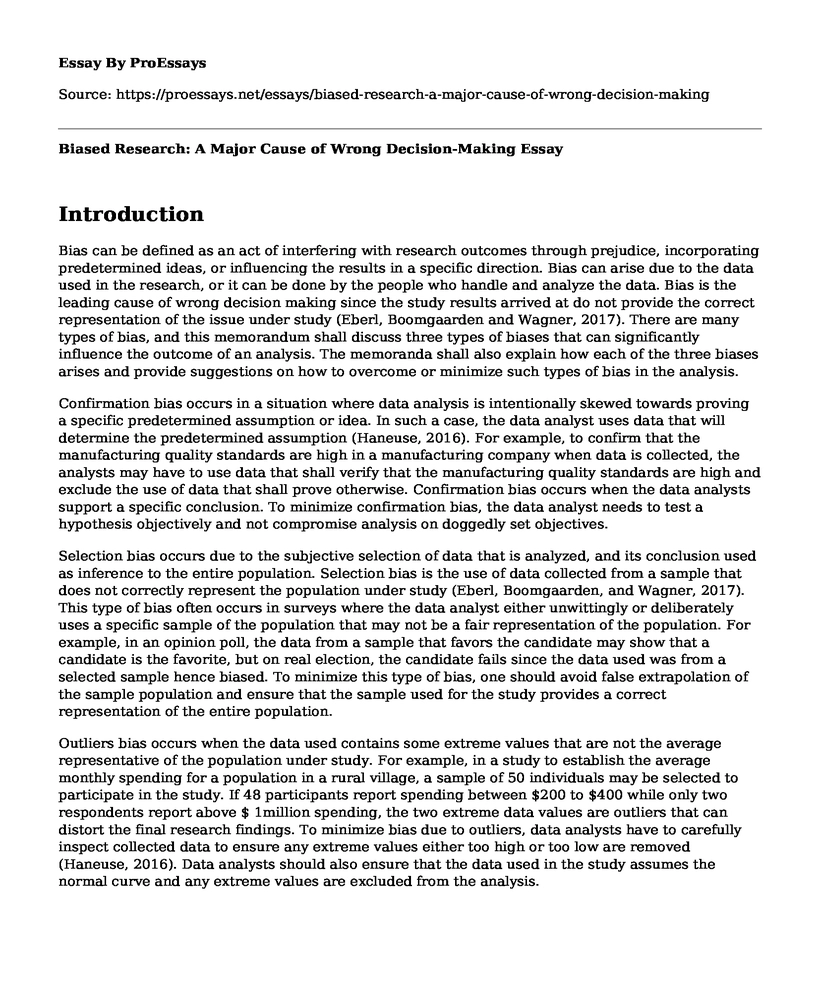Introduction
Bias can be defined as an act of interfering with research outcomes through prejudice, incorporating predetermined ideas, or influencing the results in a specific direction. Bias can arise due to the data used in the research, or it can be done by the people who handle and analyze the data. Bias is the leading cause of wrong decision making since the study results arrived at do not provide the correct representation of the issue under study (Eberl, Boomgaarden and Wagner, 2017). There are many types of bias, and this memorandum shall discuss three types of biases that can significantly influence the outcome of an analysis. The memoranda shall also explain how each of the three biases arises and provide suggestions on how to overcome or minimize such types of bias in the analysis.
Confirmation bias occurs in a situation where data analysis is intentionally skewed towards proving a specific predetermined assumption or idea. In such a case, the data analyst uses data that will determine the predetermined assumption (Haneuse, 2016). For example, to confirm that the manufacturing quality standards are high in a manufacturing company when data is collected, the analysts may have to use data that shall verify that the manufacturing quality standards are high and exclude the use of data that shall prove otherwise. Confirmation bias occurs when the data analysts support a specific conclusion. To minimize confirmation bias, the data analyst needs to test a hypothesis objectively and not compromise analysis on doggedly set objectives.
Selection bias occurs due to the subjective selection of data that is analyzed, and its conclusion used as inference to the entire population. Selection bias is the use of data collected from a sample that does not correctly represent the population under study (Eberl, Boomgaarden, and Wagner, 2017). This type of bias often occurs in surveys where the data analyst either unwittingly or deliberately uses a specific sample of the population that may not be a fair representation of the population. For example, in an opinion poll, the data from a sample that favors the candidate may show that a candidate is the favorite, but on real election, the candidate fails since the data used was from a selected sample hence biased. To minimize this type of bias, one should avoid false extrapolation of the sample population and ensure that the sample used for the study provides a correct representation of the entire population.
Outliers bias occurs when the data used contains some extreme values that are not the average representative of the population under study. For example, in a study to establish the average monthly spending for a population in a rural village, a sample of 50 individuals may be selected to participate in the study. If 48 participants report spending between $200 to $400 while only two respondents report above $ 1million spending, the two extreme data values are outliers that can distort the final research findings. To minimize bias due to outliers, data analysts have to carefully inspect collected data to ensure any extreme values either too high or too low are removed (Haneuse, 2016). Data analysts should also ensure that the data used in the study assumes the normal curve and any extreme values are excluded from the analysis.
References
Eberl, J. M., Boomgaarden, H. G., & Wagner, M. (2017). One bias fits all? Three types of media bias and their effects on party preferences. Communication Research, 44(8), 1125-1148.
Haneuse, S. (2016). Distinguishing selection bias and confounding bias in comparative effectiveness research. Medical care, 54(4), e23.
Cite this page
Biased Research: A Major Cause of Wrong Decision-Making. (2023, Feb 22). Retrieved from https://proessays.net/essays/biased-research-a-major-cause-of-wrong-decision-making
If you are the original author of this essay and no longer wish to have it published on the ProEssays website, please click below to request its removal:
- Superiority of White People in The Ethics of Living Jim Crow
- Analyzing Mixed and Visual Rhetoric for Commercial
- Is Addiction a Choice or a Disease? - Argumentative Essay
- Eliminating Gender Bias in the Workplace Paper Example
- Essay Example on Enduring Racism: Blacks in America During 18th & 19th Centuries
- Fences: A Traditionally Constructed but Touching Drama - Essay Sample
- Free Essay Sample on Women in Islam: A Journey From Inception to Reform







